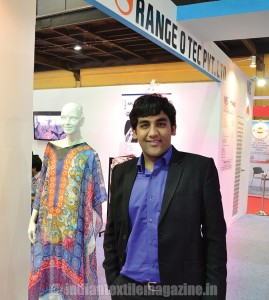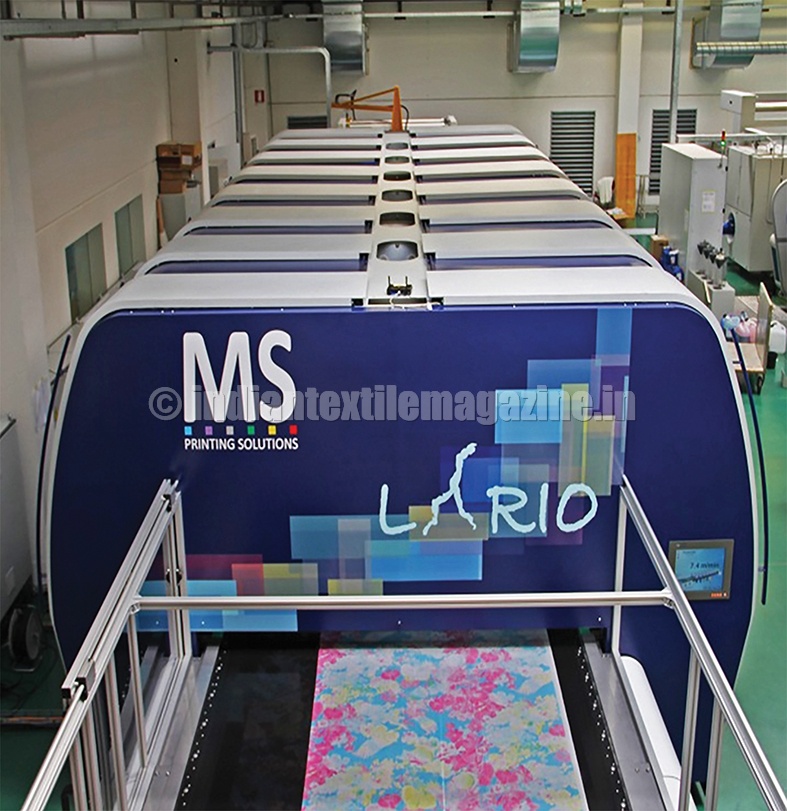By Arun Rao
Started in 2007, the Surat-based Orange O Tech Pvt. Ltd., which is into marketing of textile digital printers, has a rich lineage going back more than 50 years in fabrics trading. Though it began by marketing embroidery and schiffli machines, digital printers is now its core business.
The Orange Group represents Italian textile digital printer machine producer MS Printing Solutions, which has a range of technologies to serve the smallest as well as the largest needs of the textile printing segment.
In a chat with The Textile Magazine, Mr. Aayush Rathi, the 26-year-old Director of Orange, discusses the trends in the textile digital printing segment, the challenges faced by the segment in India, the level of aftersales service offered by Orange O Tech and several other vital issues.
The current global market share of textile digital printers is less than two per cent of the overall installed printing capacity. But the emerging trends indicate that conventional textile printers are slowly but surely switching to digital printing. More so in Europe where enforcement of pollution control norms is becoming stricter and labour and space are too expensive.
In India, penetration is less than one per cent, but again in India too pollution norms are also being implemented seriously, which can also help the growth of the segment.
During 2011-14, Orange sold 53 industrial textile digital printing machines in India and claims to have more than 50 per cent market share in the same space. At the same time, it is expecting the installation base to reach 90-100 by the end of this calendar year.
MS Printing offers four models and the Lario. The basic model starts at a production capacity of 1,000 fabric metres per day and moves on to 40,000 metres. Between them, it is possible to meet the varied requirements of any textile printer.
The smaller machines like the JP 5 Evo come at speeds of 60 metres per hour, while high-speed machines like JPK print at 500 metres per hour and the Lario delivers 2,400 metres. The highest selling machine of the company last year was JP7, which has a speed of 225 meters per hour. According to Mr. Aayush, this is the most competitive machine available in the market, and when compared with production to price, it is highly competitive as against Chinese machines.
“In the case of Lario, which was introduced less than two years ago, it is a single pass technology which can print up to 40,000 metres per day and is facing no competition in the marketplace now. The machines from our competitors can deliver a maximum of 8,000-10,000 metres per day,” says Mr. Aayush.

He adds: “There are already 10 Larios installed by MS across the world. Lario from MS is the only machine in the world which has a single pass technology. In the case of single pass technology, the heads are stationery just like a rotary printing machine, while generally in digital printers the heads are moving. Installing Lario is like getting speeds of the conventional printing machine with results of digital printing technology.”
Lario is still to be launched in India, and Orange expects a breakthrough in the next six months. It is also planning to come up with an economical model with a good production speed, the JP 6 lite.
Digital printers can prove to be very beneficial for fast fashion, where one needs short runs with a short turnaround time. The price of raw materials like digital inks too is going down. At one time, quality printing used to cost around Rs. 250 to print a metre, which is now down to Rs. 100-150 per metre.
With competition getting fiercer, and with decrease in raw material costs and high-speed industrial machines available, Mr. Aayush sees it moving down further to below Rs. 70-80 per metre in the near future. As against this, the current printing cost in a conventional textile printer for good quality prints is around Rs. 20-25 per metre.
With a digital printer, it is possible to take out samples of even one metre, with costs remaining the same, and the sample can be delivered the same day. In conventional flat-bed printers, one can print 10-20 metres, but the cost is exorbitant at Rs. 10,000-15,000 for 10-20 metre sample with sample deliveries possibly taking many days.
On the market for digital printers developing in India vis-a-vis Europe, Mr. Aayush comments: “In Europe, acceptance levels are very high as costs of running a digital or conventional printer are almost similar. In India, the major factor affecting acceptability is the cost of the machine and the raw materials.”
He further observes: “Where the initial cost and running costs are concerned, it is not possible to make comparisons between conventional and digital printers when marketing a digital printer. We market it to companies which are into printing of high-end products.”
He adds: “In times of fast fashion, today a design length is normally of 2,000 metres which would be expensive to produce in conventional textile printers. An apparel retailer is looking for 10-15 designs in a length of 30,000 metres compared to 2-3 designs earlier. This would not be affordable on a conventional setup.”
MS Orange is constantly improving its service quality as well as increasing head count of its service team members, with its USP being the Same Print Result (SPR) and the second, it’s aftersales service.
Mr. Aayush further explains SPR by saying that the print quality, whether on its smallest printing machine JP5 or the Lario, the printing results will remain the same. This is achieved because in the case of MS machines the printing head technology remains the same, whether in the smallest or in the biggest printer, while in the case of its competitors the heads differ.
Mr. Aayush himself manages the aftersales service department and wants to differentiate Orange in terms of service with other digital textile printers rather than cost.
Orange Technologies currently has service stations and 20 engineers stationed in different textile hubs like Mumbai, Surat, Delhi and Bangalore. It is also planning to start service stations in the eastern part of India very soon.
“Our focus is on delivering the best service, as sales will happen on word of mouth of the service levels delivered by us. Orange is also adding a mobile app, whereby a customer can quickly communicate with the engineer in case a machine is down, and service reports will also be available on the app,” he says.
The response time at Orange wherever a service is required is less than six hours, except in rare cases. Spares are maintained at the Surat warehouse, but to reduce downtimes, Orange is now planning to store critical spares at places where its machines are installed.
He also discloses: “Market demand for digital inks is rising with each passing year. 6-7 years back digital inks were priced at Rs. 3,000-5,000 per kg, but now it starts at Rs. 1,500 and ends at Rs. 2,600 per kg. I foresee that this price will further reduce and may nearly halve due to competition in the next 3-4 years, and this will help create demand for digital printers in India.”
